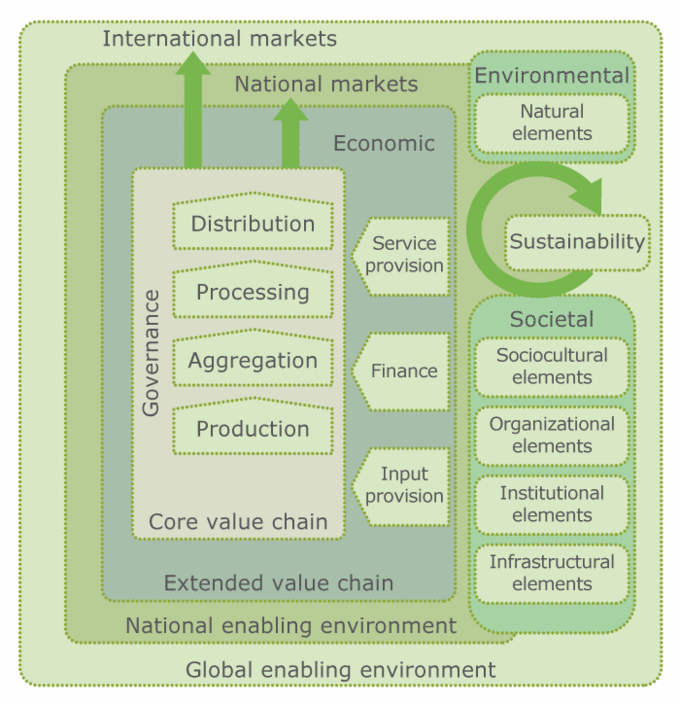Food systems and value chains: definitions and characteristics
Systems consist of elements and interconnections, and serve a purpose or function (Meadows, 2009). Food systems encompass the entire range of actors and their interlinked value-adding activities involved in the production, aggregation, processing, distribution, consumption and disposal of food products. Food systems comprise all food products that originate from crop and livestock production, forestry, fisheries and aquaculture, as well as the broader economic, societal and natural environments in which these diverse production systems are embedded (FAO, forthcoming). Activities in the food system also include the provision of inputs and services in the extended value chain, which support (or constrain) the flow of goods through the different stages of the core value chain. These diverse inputs and services may include drought-tolerant seeds, researchers studying climate-smart agriculture interventions, extension services to promote climate-smart agriculture, low-carbon machinery, and climate insurance. Elements in the societal and natural environment in which food production systems are embedded form the enabling environment that influences food systems and will have implications for the design and uptake of climate-smart agriculture interventions. Societal elements include the widespread public perceptions of climate change, specific national plans for climate change mitigation and adaptation (e.g. Intended Nationally Determined Contributions), and global agreements like the Paris Climate Agreement. Natural resources (e.g. land, soil, water, and genetic diversity) and their management, as well as other natural processes, especially those linked to climate, are essential elements of the enabling environment for developing sustainable food systems. The FAO food system wheel (Figure B10.1) depicts the different elements of the food system and the interactions between the various levels.
The overall goals of FAO in developing sustainable food systems are to reduce poverty and ensure food security and nutrition for all, in such a way that does not compromise the capacity of the economic, societal and natural environments to provide food and nutrition security for future generations (HLPE, 2014). Sustainable food systems and the sustainable food value chains (SFVCs) that they comprise are economically sustainable, in that they are profitable; socially sustainable, meaning that they deliver broad-based benefits for society; and environmentally sustainable, such that they have a positive or neutral impact on the environment.
Figure B10.1. Food system wheel – elements and interactions

- Source: FAO, forthcoming
Understanding food systems and employing systems thinking is critical to identifying the root causes of system failures, including the areas that make food systems vulnerable to climate risks and create inefficiencies that lead to excessive greenhouse gas emissions. It may be possible to introduce climate change adaptation and mitigation measures at each interacting level: the core value chain, the extended value chain and the enabling environment. Taking a systems’ view and examining the interaction of all the food value chains within the food system in question can help identify vulnerabilities and formulate resilience strategies. For example, highly connected systems with a disproportionate reliance on a few staple crops from just a few productive regions are extremely vulnerable. On the other hand, greater on-farm diversity, more diversified national food baskets and increases in the number of regions with diversified food baskets could substantially increase the resilience of global food systems (WEF, 2017).
Food systems are composed of subsystems (e.g. farming systems, market systems, waste management systems, and input supply systems) and interact with other systems (e.g. energy systems, trade systems, and health systems). As such, a structural change in the food system might originate from a change in another system. For example, a change in political leadership may have an impact on investments in food systems. Policies that promote biofuels in the energy system will also likely have a significant impact on food systems.
Global, national and local food systems are extremely complex and dynamic, evolving over time. Therefore, it is necessary to conduct an analysis at a workable scale, which can be operationalized through a value chain approach. This type of approach is one of several possible approaches to analyse food systems. Other approaches, which are beyond the scope of this module, include the territorial approach (OECD, FAO, UNCDF, 2016) and a market systems approach (Humphrey, 2014). Figure B10.2 illustrates the FAO sustainable food value chain development (SFVCD) framework. The SFVCD framework takes a dynamic, systems-based approach to measuring, understanding and improving the sustainability performance of the food value chains that make up food systems. It analyses the relationships between the three interlinked layers of the core value chain, the extended value chain and the enabling environment.
Figure B10.2. Sustainable food value chain framework

- Source: FAO, 2014

